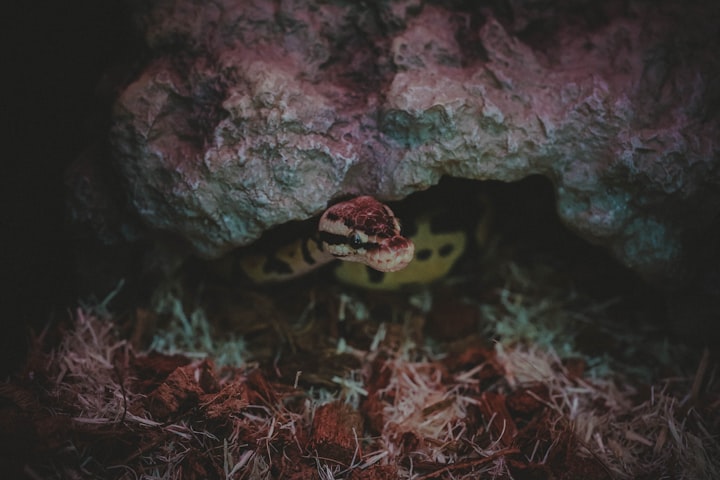Ball Python Care Sheet
How To Properly Care For A Ball Python

The Ball Python is one of the most popular pets within the reptile enthusiast community. They are easy to care for, docile and beginner friendly! They come in array of beautiful patterns and colors, otherwise known as "morphs" and are overall intriguing creatures. Sometimes I would just sit there next to my python's feeding tank and watch her stalk her prey. I normally have a pretty short attention span (thanks ADHD) but I could seriously sit there and watch her for days.
Before I bought Dahlia (my ball python), I was unsure of what I needed in order to be able to keep her healthy. The only thing I really knew was that she was going to eat rodents. That was pretty much it. Naturally, I opened up my laptop and started doing research. I must have looked through hundreds of pages on the internet and a dozen videos on YouTube. After a while of watching all those videos and reading all those articles, I decided I was ready. I was ready to take the leap and purchase my first snake.
I have always loved animals but this was my first ever experience with reptiles in general. I learned so much from this experience and have since helped educate people on proper care and selecting their first scaly friend.
If you want to know which reptiles are beginner friendly, check out my article here.
I'm sure you're here because you have either obtained your snake, are thinking of getting one or you're generally interested and curious about snakes. They're all good reasons and i'm excited to be able to guide you through this.
Either way, let's go ahead and dive in to it.
Size and Lifespan
Ball python hatchlings are approximately 10 inches in length. Female adult ball pythons average 3 to 5 feet long, and adult male ball pythons average 2 to 3 feet long. A mature female ball python tend to be much larger than their male counterpart. A 5-foot ball python is considered big, although lengths of 6 feet or more have been reported.
If properly cared for, ball pythons can live about 30-40 years. Make sure you are aware of this fact before obtaining your ball python.
Handling and Temperament
Ball pythons are one of the easiest reptiles to handle.
Like with any animal, initial contact should be slow and steady. Trust is developed over a period of time by gently handling them for a few minutes every day for the next several weeks.
Once your ball python realizes you are not a threat, they can be handled with ease and are a lot of fun to hold. Make sure you do not handle your snake while they are shedding or right after they have eaten. Waiting a couple of days after they have eatten is essential to ensure they don't become stressed and regurgitate their meal.
Enclosure
Being relatively inactive (usually more active at night) an enclosure of about 30 gallons in size is great for an adult ball python. approx 36” x 18” x 12”
Some snake keepers, and especially breeders keep their ball pythons in a rack system. Most ball python rack systems use tubs of 30”+ x 18” x 6” high. An advantage to keeping snakes in tubs is it is far less expensive and easier to keep clean.
Having an intricate enclosure made up of multiple hides, branches, leaves and decorations can be really nice to have for your ball python. Just remember you will have to make sure to keep everthing disinfected and clean. It all depends on you and what you can keep up with.
Lighting and Heat
Ball pythons need a basking spot of about 90 degrees and an ambient temperature in the low 80s.
Depending on your house temperature, you may or may not need heat lighting to maintain appropriate temperatures inside your ball python's enclosure.
Having a thermometer inside, at each end of the enclosure is important so you can keep track of the thermal gradient. Some household light bulbs will emit enough heat to heat a tank, but if your tank is larger, you might need more than one heating lamp.
Some people choose to use heating pads at the bottom of the enclosure. This is not always necessary and it can also be more difficult to keep track of the temperature this way. There have been cases where the snake lays on the heating pad and have gotten burned. As a result, I try not to ever use heating pads or rocks.
In my experience, heating lamps are the way to go and my snakes were perfectly content with this method.
Humidity and Substrate
Aside from purchasing thermometers, make sure you get a hygrometer. This is what measures the amount of humidity in said enclosure.
There are also two in one options which you can find here.
The ideal humidity range for ball pythons in captivity is around 55%. When the snake is going into shed, you can increase the level to around 65%. This will help your ball python separate the old outer layer of skin.
When preparing substrate for the enclosure, you have the option of putting the substrate in dry or damp. I used to prefer mixing a little bit of water (Don't put too much. You don't want your snake to swim in it.) in to the coconut fiber, mix it up and put it straight in to the enclosure. This will help keep their tanks at a more consistent level of humidity.
If you have an under the tank heater, you can place the water bowl above it. This acts as a humidifier. The heat warms the water, which causes water vapor to rise. You can also try using a substrate material that increases the humidity inside the cage. Cypress mulch or coconut fiber are good examples of such a substrate.
My top recommedation for substrate here.
One of my favorite methods for keeping up with the humidity levels is a spray bottle. You can purchase a regular, empty spray bottle from any grocery or craft store. You can find a mister which eliminates the need to constantly have to pump the spray bottle for water. Make sure to check the humidity levels throughout the span of the day. You can mist more or less if needed.
You can create a moisture box by cutting a hole in the top of a plastic box. Partially fill the box with some type of moist substrate like cypress mulch or damp paper towels, and the snake can go in and out of the box as needed.
If you are using a glass terrarium screen top, you can partially cover the top to help retain moisture. Just make sure you're not putting anything near a heat lamp which could pose a fire hazard and to make sure there is still enough airflow inside the snake enclosure.
Food and Water
Fresh, chlorine free water should be available at all times for your snake. Their water serves a few purposes. One of them is to help keep humidity up, the second is for them to soak in to prepare for shedding. The third and most obvious, is for them to drink.
Water should be in a wide, shallow dish. There are multiple dishes designed for snakes, specifically.
You can find them here.
As far as food goes there are three choices. You can use frozen, freshly killed and live. Typically if you go to a reptile specialty store or a pet store, they will provide these services for you followed by specific instructions. You can refer to this graph if you want to know more about specifics.

DISCLAIMER: This article contains affiliate links, which means that if you click on one of the product links, I’ll receive a small commission. This helps support me and helps me continue to create blog posts for you! Thank you for the support! Everything in this article is based on information I learned from personal experience working in animal hospitals and being a long time pet owner. Please do your own research before making any important decisions.
About the Creator
Sandra Ivonne
A Queer, Mexican American writer/artist who enjoys black and white horror films, animals, swearing, giving her opinion with no filter and drinking copious amounts of coffee.






Comments
There are no comments for this story
Be the first to respond and start the conversation.